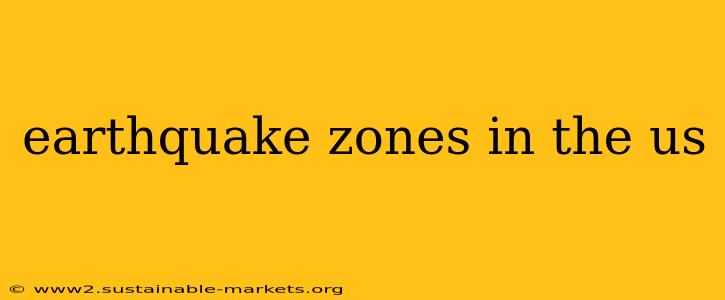The United States, while geographically vast and diverse, isn't immune to the powerful forces of nature, including earthquakes. Understanding the earthquake zones within the country is crucial for preparedness, building safety, and informed decision-making, especially for those living in or considering moving to high-risk areas. This comprehensive guide delves into the major seismic zones across the US, outlining their characteristics and the potential risks they pose.
Major Earthquake Zones in the US
The United States Geological Survey (USGS) provides detailed information on seismic activity, classifying areas based on their historical earthquake frequency and intensity. While the entire country experiences some level of seismic activity, certain regions are significantly more prone to powerful earthquakes.
1. The Pacific Northwest: Cascadia Subduction Zone
The Pacific Northwest, encompassing parts of Washington, Oregon, and Northern California, sits atop the Cascadia Subduction Zone, one of the most significant earthquake hazards in North America. This zone is where the Juan de Fuca tectonic plate is sliding beneath the North American plate. This subduction process can generate massive megathrust earthquakes, capable of exceeding magnitude 9.0. The potential for a catastrophic earthquake and subsequent tsunami in this region is a serious concern.
2. California: San Andreas Fault System
California is synonymous with earthquakes, largely due to the infamous San Andreas Fault system. This complex network of faults is the boundary between the Pacific and North American plates, resulting in frequent seismic activity ranging from minor tremors to significant earthquakes. The southern section of the San Andreas Fault is particularly concerning due to its potential for major earthquakes. Other significant fault lines in California include the Hayward Fault and the San Jacinto Fault, contributing to the state's high seismic risk.
3. Alaska: A Highly Active Seismic Region
Alaska, situated at the intersection of several tectonic plates, experiences frequent and powerful earthquakes. The Aleutian Islands, in particular, are highly active, with numerous earthquakes occurring annually. The region's geological instability makes it one of the most seismically active areas in the US, posing significant risks to infrastructure and populations.
4. The Central and Eastern United States: A Lesser-Known Risk
While the western US is often associated with earthquakes, the central and eastern parts of the country are not entirely exempt from seismic activity. While earthquakes in these regions are generally less frequent and less powerful than those in the West, they can still cause significant damage due to the older building codes and less earthquake-resistant infrastructure present in many areas. The New Madrid Seismic Zone, located in the central US, is a particularly noteworthy area, with the potential for significant earthquakes. Historical records show that this zone has experienced powerful earthquakes in the past.
Understanding Earthquake Risk: Beyond Geographical Location
While knowing the location of major fault lines is crucial, understanding earthquake risk involves more than just geography. Factors like:
- Building codes and construction: Older buildings may not be designed to withstand strong seismic activity.
- Soil conditions: Certain soil types can amplify the shaking during an earthquake.
- Proximity to fault lines: The closer a location is to a fault, the greater the risk.
all play a vital role in determining the level of risk.
Preparedness is Key
Regardless of your location, preparedness is paramount. Familiarize yourself with earthquake safety procedures, create an emergency plan, and ensure your home and family are ready for a potential seismic event. This includes securing heavy objects, having an emergency kit readily available, and knowing evacuation routes.
This guide provides a general overview. For specific information regarding earthquake risk in your area, consult the USGS website and your local emergency management agency. Staying informed and prepared is the best way to mitigate the potential risks associated with living in earthquake zones within the US.

